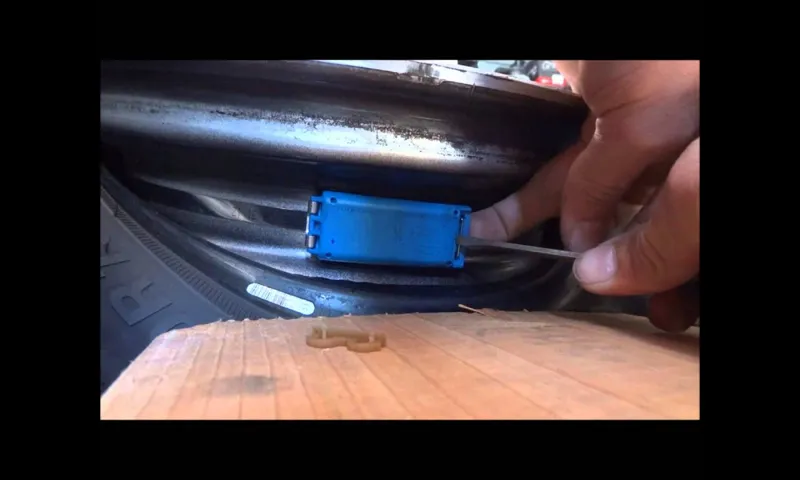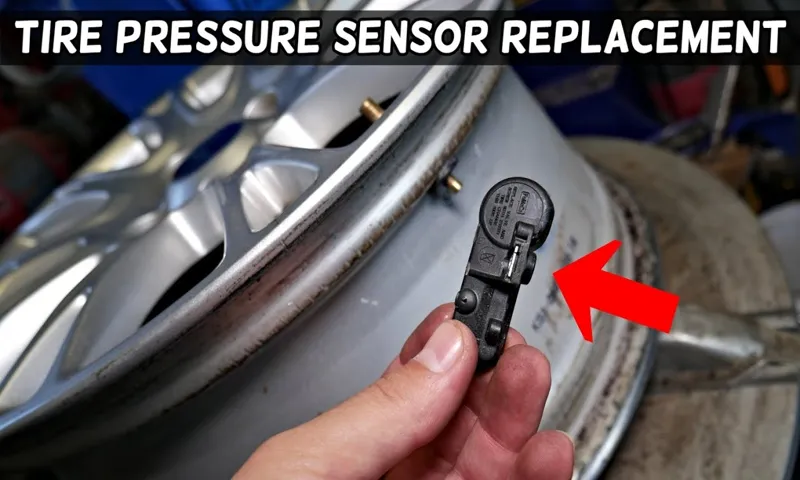Have you ever had trouble with your tire pressure sensors? Sometimes these sensors malfunction or become damaged, causing inaccurate readings and inconvenience. Removing these sensors can be a solution, but it’s important to do it correctly and safely. In this blog post, we’ll discuss the reasons for removing tire pressure sensors, the steps to do it yourself, and the benefits of doing so.
So grab a wrench and let’s get started!
Table of Contents
Overview of Tire Pressure Sensors
If you need to remove a tire pressure sensor, there are a few steps you should follow to ensure you do it safely and effectively. First, make sure you have the right tools for the job: typically, you’ll need a valve stem puller and a torque wrench. Once you’ve got your tools in hand, start by disconnecting the sensor from the valve stem and removing it from the wheel.
Next, you’ll need to remove the sensor from its housing by either unscrewing it or prying it loose with a flathead screwdriver. Finally, when you’re ready to reinstall the sensor, make sure you torque it to the manufacturer’s recommended specifications to ensure a proper seal. Keep in mind, removing the tire pressure sensor may also trigger your vehicle’s TPMS warning light, so it’s important to reset it once the sensor has been replaced.
Removing a tire pressure sensor may seem daunting, but with the right tools and a bit of know-how, it’s a manageable task that most car owners can handle on their own.
Understanding the Function and Importance of TPMS
TPMS, tire pressure sensors If you’re not familiar with tire pressure sensors, also known as TPMS, they are a small device that fits inside each of your car tires and sends pressure readings to your vehicle’s computer. These sensors are essential for efficient and safe driving because they help you monitor your tire pressure, alerting you when it’s time to add air to your tires. Overinflated or underinflated tires can lead to numerous problems such as reduced fuel efficiency, tire wear, and even blowouts on the road, which can be hazardous.
Therefore, understanding the function and importance of TPMS is crucial for every driver. With these sensors in place, you can keep your vehicle’s tires at the optimal pressure level, ensuring that your car drives smoothly and safely on the road.

Common Reasons for Removing TPMS
Tire Pressure Sensors Tire pressure sensors, also known as TPMS, are electronic devices that are installed in tires to monitor the air pressure and temperature. They are becoming increasingly popular due to their ability to enhance safety and fuel efficiency. TPMS is particularly important when it comes to preventing blowouts and other types of accidents related to tire pressure.
However, there are certain situations where removing TPMS may be necessary. One common reason for removing TPMS is when one or more sensors are malfunctioning, causing the system to produce inaccurate readings. Another reason is when replacing wheels or tires that were not originally equipped with TPMS.
This can be done to save money or to install custom wheels that may not be compatible with a TPMS system. Whatever the reason for removing TPMS, it is important to remember that this can compromise safety and fuel efficiency. It is recommended to consult with a professional to ensure that any modifications to your vehicle are done safely and legally.
Preparation for Removing TPMS
If you’re planning to replace your tires or just make some adjustments, knowing how to remove the tire pressure sensor is a crucial part of the process. First and foremost, make sure you have all the necessary tools to safely remove the sensor without damaging it. Typical tools include a jack, lug wrench, needle-nose pliers, and a valve stem removal tool.
Once you have these items, start by unscrewing the valve stem cap and using the valve stem removal tool to remove the valve stem from the tire. This will release the air pressure and allow you to safely remove the tire. After that, use the needle-nose pliers to carefully remove the sensor from the valve stem.
Be cautious during this process to avoid damaging the sensor. Once you successfully remove it, make sure to store it in a safe place until you need to reinstall it later. Knowing how to remove the tire pressure sensor is a straightforward process, but being careful and taking your time is key for a successful removal.
Gather Necessary Tools and Equipment
When it comes to removing TPMS, proper preparation is key. Before starting the process, make sure you have all the necessary tools and equipment ready and easily accessible. This generally includes a tire pressure gauge, valve stem tool, torque wrench, and diagnostic tool.
It’s important to double-check that these tools are suitable for the type of TPMS system you are working with, as different vehicles may have different requirements. In addition, it’s crucial to ensure that your workspace is clean and organized to avoid losing any small components during the removal process. By taking the time to gather the right tools and properly prepare your workspace, you’ll be well on your way to successfully removing the TPMS system from your vehicle.
Identify Which Sensors Need to be Removed
When preparing to remove TPMS, it is essential to identify which sensors need to be removed. This step is crucial as some sensors may not be compatible with your vehicle, which can cause malfunctions. It is important to have the correct information about your vehicle’s make and model to cross-check with the sensor’s compatibility.
Before proceeding, make sure to have the appropriate tools and equipment. You may need a TPMS tool, a lug wrench, and a valve stem core removal tool. It is recommended to read your vehicle’s manual to familiarize yourself with the parts of the TPMS system and the recommended removal procedure.
Proper preparation is critical to ensure a safe and successful removal process.
Park Vehicle on a Level Surface and Securely Block Tires
When it comes to removing TPMS (Tire Pressure Monitoring System) from your vehicle, the first step is to park your vehicle on a level surface and securely block the tires. This may seem like a simple step, but it’s crucial to ensure that the vehicle doesn’t roll during the removal process. You’ll want to make sure that the blocks of wood or chocks you use are sturdy and properly placed to prevent any accidents.
Once you’ve secured the vehicle, you can start preparing to remove the TPMS. It’s important to note that different vehicles may have different procedures for removing the TPMS, so it’s always a good idea to consult your owner’s manual or a trusted mechanic before getting started. With proper preparation and care, you can safely and efficiently remove the TPMS from your vehicle.
Step-by-Step Guide to Removing TPMS
If you’re wondering how to remove a tire pressure sensor, don’t worry, it’s not as complicated as it may seem. The first step is to locate the sensor, which is typically situated on the valve stem of the tire. Once located, use a valve stem removal tool to unscrew the sensor from the valve stem.
Take care not to damage the sensor or valve stem while doing this. It’s important to note that removing the sensor will trigger a warning light on your dashboard. To prevent this, you can use a TPMS reset tool to reset the system after you’ve removed the sensor.
This will ensure that the warning light doesn’t stay on and that the system continues to work properly. Overall, removing a tire pressure sensor is a simple task that can be done by anyone with basic knowledge of car maintenance.
Step 1: Remove Valve Cap and Core
Removing TPMS can be a little intimidating, but it’s actually a pretty straightforward process. The first step is to remove the valve cap and core, which is where the TPMS sensor is located. This can be done using a valve core remover tool, which you can pick up at most auto parts stores for just a few bucks.
Simply place the tool over the valve stem and twist it counterclockwise until the core comes loose. Be sure to keep the valve cap and core in a safe place so you don’t lose them. Once the core is removed, you’ll be able to access the TPMS sensor and remove it from the wheel.
By following these simple steps, you can remove your TPMS with ease and get back on the road in no time.
Step 2: Remove the Nut and Washer
Now that you’ve successfully removed the valve cap and deflated the tire, the next step in removing the TPMS is to remove the nut and washer. Using a wrench, loosen the nut and carefully slide the washer off the valve stem. Be sure to keep track of both the nut and washer as they are easy to lose.
Once the nut and washer are off, gently pull the TPMS sensor away from the valve stem being careful not to damage the valve stem. This step may take a bit of effort since the TPMS sensor can be firmly seated on the valve stem. Remember to take your time and be patient.
Don’t rush or force the sensor off as this can cause damage to both the sensor and valve stem. With the sensor removed, you’re one step closer to replacing your TPMS and ensuring your vehicle is driving safely on the road.
Step 3: Carefully Remove the TPMS Sensor
To remove the TPMS sensor, it’s essential to proceed carefully to avoid damaging it. First, loosen the sensor nut using a wrench, but be sure not to touch the valve stem located in the center of the sensor. It’s crucial to prevent any damage to the valve stem, as it can cause air leaks.
Once the nut is loose, gently remove the sensor from the valve stem by using the specially designed TPMS tool. You can do this by placing the tool around the sensor and twisting it, separating the sensor from the valve stem. Take care not to apply too much pressure as it can cause the valve stem to snap.
Slowly and carefully remove the sensor to avoid any damage and keep it aside for reinstallation later. With this process complete, you’ve got one step closer to replacing your TPMS sensor. Remember to handle the sensor with care, and with the aid of the right tool, remove it successfully.
Step 4: Inspect the Sensor and Valve Stem for Damage
When removing the TPMS, it’s vital to inspect the sensor and valve stem for any signs of damage. Any cracks, leaks, or other damage can negatively impact the accuracy of the TPMS and lead to incorrect readings. To begin, remove the sensor from the valve stem and inspect both pieces carefully.
Look for any signs of wear and tear, such as cracks or cuts, that could lead to air leaks. It’s also essential to check the valve stem for damage or corrosion that could affect the TPMS’s accuracy. If any issues are found, the sensor or valve stem must be replaced to ensure the system continues to function correctly.
Taking the time to inspect both components thoroughly can save you time and money by preventing future TPMS failures.
Conclusion
In conclusion, removing a tire pressure sensor may seem like a daunting task, but it can be done with the right tools and a little bit of know-how. Remember to be patient and take your time when working with delicate electronic components. And if all else fails, just pretend that the tire pressure sensor was never there in the first place – hey, ignorance is bliss, right? Happy wrenching!”
Reinstalling TPMS Sensors and When to Contact a Mechanic
“reinstalling TPMS sensors” When reinstalling TPMS sensors, it’s important to make sure they are properly aligned and securely fastened. Start by removing the old sensors and cleaning the valve stem to remove any debris. Then, align the new sensor and screw it onto the valve stem, being careful not to over-tighten it.
Once all sensors are installed, make sure to properly program them to the vehicle’s system. It’s important to note that if you are not comfortable or confident in your ability to install TPMS sensors, it’s best to contact a qualified mechanic. They can ensure that the sensors are installed correctly and programmed to the vehicle’s system, avoiding any potential issues down the road.
Overall, reinstalling TPMS sensors can be a straightforward process, but it’s important to take the necessary precautions to ensure they are installed correctly and functioning properly.
FAQs
What is a tire pressure sensor?
A tire pressure sensor is a device that monitors the air pressure in your tires and alerts you if the pressure drops below a certain level.
How does a tire pressure sensor work?
A tire pressure sensor works by transmitting data to your car’s computer system, which then alerts you if the pressure in any of your tires is too low.
Can tire pressure sensors be reset?
Yes, most tire pressure sensors can be reset using a special tool or by following specific instructions in your car’s manual.
How often should I check my tire pressure sensors?
It is recommended that you check your tire pressure sensors at least once per month to ensure that they are working properly.
Can tire pressure sensors be replaced?
Yes, tire pressure sensors can be replaced if they become damaged or stop working correctly.
How much does it cost to replace a tire pressure sensor?
The cost to replace a tire pressure sensor can vary depending on the make and model of your car, but typically ranges from $50 to $250 per sensor.
Can I drive with a faulty tire pressure sensor?
While it is possible to drive with a faulty tire pressure sensor, it is not recommended as it can lead to decreased fuel efficiency, uneven tire wear, and potential safety issues.


